By Katje Sabin (mamagotcha)
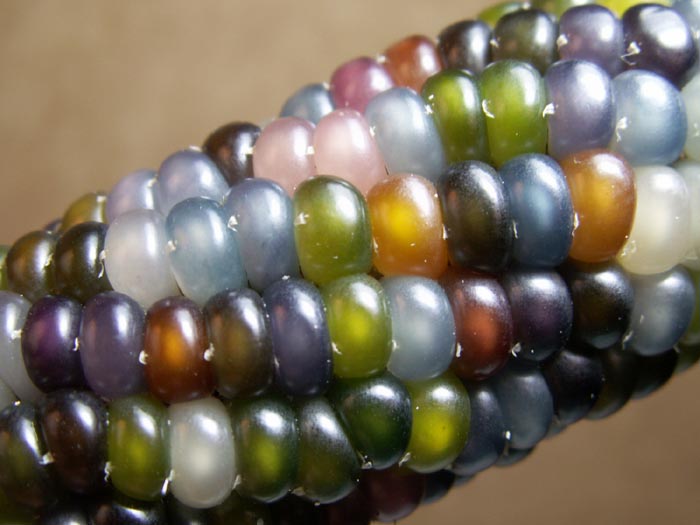
In May of 2012, the above photo of an ear of corn featuring astonishingly psychedelic colors made the rounds on the Internet. “NOT PHOTOSHOPPED!” blared the blogs. Being a rainbow aficionado myself, I briefly toyed with the idea of tracking down the seeds of this marvelous grain so I could grow it, but I didn’t yet have a dedicated garden space. Besides, it wasn’t yet commercially available.
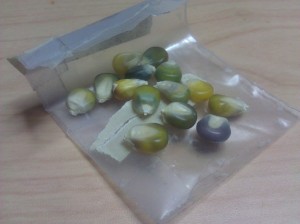
Later that year, I dug out three little 4’x4′ garden boxes in my backyard, with permission from my landlord, and started dreaming about what to grow in it. The tiny amount of the fabulous corn seed available for the year was already sold out from the only company legitimately selling it, but I decided to take my chances with an eBay seller. Finally I had my hands on a tiny Ziploc baggie filled with a few dozen nondescript nuggets of what looked like run-of-the-mill Indian corn.
The whole episode had a slightly…ahem…seedy feel to it. I really had no idea where this corn had come from. The seller was new, and I wondered whether I’d let myself be ripped off, but there were no more seeds to be found and I decided to take the gamble. I planted them in May of 2013 and crossed my fingers.
A Sacred Crop
In the course of trying to track down these seeds, I found the story of the man behind the stained-glass corn in a December 2012 issue of Mother Earth News. Way back in the 1930s, on the parched Oklahoma plains, a young half-Cherokee farm boy named Carl Barnes decided to spend more time with his Native American grandfather. He learned the traditional rituals surrounding the planting, growing and harvest of native seeds, as well as the stories and wisdom surrounding those rituals.
As he matured, Barnes studied agricultural education and worked with the state’s Cooperative Extension Service (as well as a stint in the Kansas Highway Patrol). But he remembered the lessons from his youth as he continued to farm his family land. Soon, he noticed that some of the native ancestral types of corn his grandfather had taught him about were appearing in his own crops of older varieties that were still being farmed. He began a decades-long project of isolating and cultivating these variants, which had been previously lost to the Native American tribes – particularly those who had been forced to relocate in the 1800s.
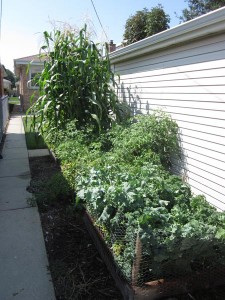
“He was able to re-introduce specific corn types to the elders of those surviving tribes, and this helped their people in reclaiming their cultural identities. The corn is, to them, literally the same as their blood line, their language, and their sense of who they are,” wrote Greg Schoen, Barnes’ student and the author of the Mother Earth News article. Barnes’ dedication to bringing back these sacred crops back into tribal hands earned him the spirit name of White Eagle.
Barnes frequently traveled to events with a portable display featuring some of the traditional corns he’d isolated, and one such gathering is where Schoen met him in 1994. “I knew from the start there was something magical in that seed and that I needed to get to know Carl better,” Schoen wrote.
In the late ’90s, Barnes gave Schoen a handful of some of the most brightly colored seeds; this was the corn that would later become known worldwide as Carl’s Glass Gems.

Schoen started growing the seed seriously around 2005, and in 2009 he gave samples of the seed to Bill McDorman, the director of Native Seeds/SEARCH (currently the only commercial source of Glass Gem seeds). It’s a nonprofit organization dedicated to the preservation of indigenous crop seeds from the American Southwest and northern Mexico.
“I was blown away,” McDorman said about his first harvest of this colorful crop, as quoted on the Native Seeds website. “No one had ever seen corn like this before.” It was McDorman’s posting of one of Schoen’s photos in May of 2012 that caught the attention of gardeners everywhere, and cemented the name “Glass Gem” as the title of this particular variation.
Today, Glass Gem seed has been grown all over the United States, in Kenya, Mexico, Israel, Australia, and India. “My purpose has been to make sure this corn gets out there… to circulate and become part of the public domain,” said Schoen in the Mother Earth News story. “My only desire has been that it is grown in a respectful way and shared freely.”
Growing Glass Gems
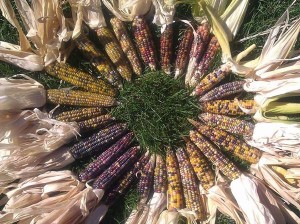
My little corn sprouts, planted in about a dozen little hills of three seeds each, grew quickly. The cute little bush bunnies that hang out in our neighborhood decimated my baby spinach and kale starts, so I erected a knee-high fence of chicken wire to spare the survivors. That did the trick.
Some days, I swore I could see the stalks grow in front of my eyes. Within two months, the little plants were towering; by mid-July, they had topped the garage eaves. They were at least eight feet tall, and soon the tassels were waving and gently sifting their pollen over the swelling ears topped with their long, flowing silks. My poor husband had developed a nasty corn pollen allergy, and spent many miserable hours soaking his affronted eyes under a cool washcloth after the golden dust wafted over him each day as he returned from work.
In August, I couldn’t wait any longer; I had to peek into one of the ears and see the colors! So I chose the most-developed-looking ear, with the driest silks, and tentatively peeled back the tiniest bit of husk to see what was going on in there. All I saw were tiny white pearls, lined up perfectly but with not a bit of color. I was certain I’d been ripped off by my eBay source, and emailed him in a high dudgeon, demanding to know what was up. He politely tolerated my doubting Thomas-style note and sent a pretty array of photos from his own crop, saying that the kernel colors would develop with time and asking me to be patient.
Sure enough, a week later I peeked again and started to spy the palest blush of blue on some of the little white nubs. I sheepishly apologized to my long-suffering seller, and settled in for an agonizing wait, with daily inspections of the already-opened ear.
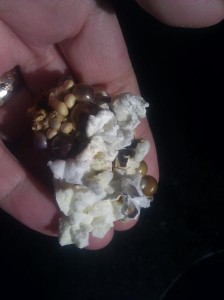
The best colors and clearest gemlike effects are supposedly the strongest once the husks and stalks have dried to yellow (according to my fellow growers on a Glass Gem Facebook group), but I finally gave in and pulled off the the first ear whose silks had browned. The colors were truly magnificent – my corn consisted of a range of kernel colors that spanned the entire spectrum, with a few black and white ones for good measure. While several of the subsequent ears also shared this range, that first ear was the best example from the entire crop.
Glass Gem is what is known as a flint corn, as opposed to the sweet corn we are accustomed to eating off the cob during summer cookouts. It’s closer to the yellow and white dent corn used for livestock feed and processed foods, and popcorn. Flint corn has a thicker hull than sweet corn, and does better in wetter/cooler climates (good news for me!). Glass Gem is edible and can be popped or ground for cornmeal, but by far its most popular use is decorative.
A Connection to the Past

It’s been a fantastic adventure for me, tracking down and growing this incredibly beautiful corn. That first ear I harvested, I carried around for several days. I couldn’t stop touching it, turning it in the sunlight…I was thoroughly captivated and enchanted.
Schoen’s words resonated with me: “The corn became like scrolls of ancient manuscript, and the mere handling of it seemed to confer the transformative power it held.” When I hold my corn, I think about all the generations of native people growing and harvesting their crops, and the fact that I could trace a line back through the centuries in the genes of the ear I held in my hand. The seeds I hold now have ancestors just as I do.
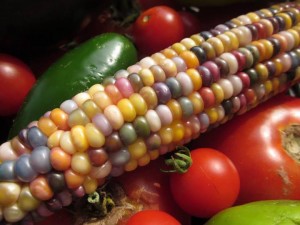
While I knew that I had some Native American blood in my history, I’ve never had a tangible connection to that part of my past. There’s a part of me that wonders… did one of my own great-great Potawatomi grandmothers grow corn whose offspring led to the ear in my own hand today? When I grind and eat my corn, am I nourishing my cells with the same genetic material that kept my family alive a thousand years ago? Thanks to the efforts of people like Barnes and Schoen, maybe that notion isn’t quite so farfetched as one might think.
When I plant the seeds I grew in my future gardens, maybe I will be contributing a link in the chain towards the crops that will someday feed my children’s children. As Carl Barnes often said: “The seed remembers.”
Your Turn
Note: If you are interested in growing this spectacular corn, you have several choices: Native Seeds/SEARCH has finished processing its 2013 crop and the seeds are now available here. You can also take your chances with Amazon.com or eBay.com sellers. Or you can comment on the thread associated with this article, and arrange to collect some seed directly from me for free.


